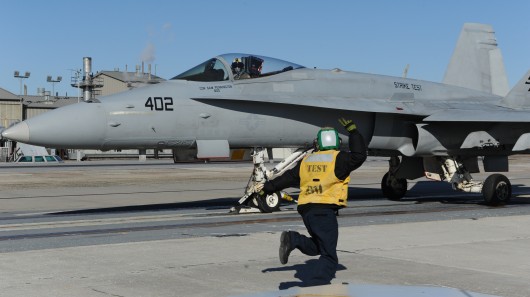Electromagnetic system to replace steam launch systems on US Navy carriers
By David Szondy
June 23, 2014
A fighter plane taking off from a strike carrier is a dramatic sight – not the least because of the woosh and plume of steam as the catapult blasts the aircraft into the air. In a few years, such launches may still be dramatic, but they’ll also be a bit quieter and very plume-free. That’s because the US Navy has completed testing of its Electromagnetic Aircraft Launch System (EMALS); clearing it for use on the new Gerald R Ford-class aircraft carriers.
When the Navy launched an F/A-18C Hornet for the first time as part of the second and final test phase of the EMALS at the Joint Base McGuire-Dix-Lakehurst, New Jersey land-based test site, it opened the way for the system’s deployment on US aircraft carriers starting with the USS Gerald R Ford (CVN 78) that is currently under construction at the Huntington Ingalls Industries shipyard in Newport News, Virginia.
Under development for over 25 years, EMALS is the first new carrier catapult technology in 60 years to advance to practical application. Instead of using a piston forced along by a head of steam, it uses computer-controlled, solid-state electrics to propel an armature down a track.
The EMALS is designed to replace the steam-powered launch system that has been the standard on strike carriers since the 1950s. According to the Navy, EMALS is capable of being used by a wide variety of aircraft, is near-silent, and enjoys smoother acceleration and a more consistent launch speed. It also has higher launch energy, is more reliable, mechanically simpler, and is easier to maintain.
The Electromagnetic Aircraft Launch System (Image: US Navy)
EMALS has already been tested in the first phase of ACT testing that ended in 2011 and included 134 manned launches of aircraft, including the F/A-18E Super Hornet, T-45C Goshawk, C-2A Greyhound, E-2D Advanced Hawkeye and F-35C Lightning II. The second phase, which ended in April, saw launches of the EA-18G Growler and F/A-18C Hornet. In all, 452 manned launches were conducted.
"The successful manned-aircraft test launches replicated various carrier situations to demonstrate that the catapult would provide the required aircraft end-speed and to validate EMALS launch-critical reliability," says George Sulich, EMALS integrated test team lead.
The EMALS has already been installed on the Gerald R Ford and will also be included on all subsequent Ford-class carriers. In late 2015, the Gerald R Ford will conduct dead-load launches using weighted sleds in anticipation of later manned tests.
"This is an amazing and pivotal time for naval aviation," says Captain Frank Morley, who leads the F/A-18 and EA-18G Program Office (PMA-265). "Who would have thought 35 years ago that the Hornet would launch from anything other than steam catapult technology. We are fortunate to witness this historic milestone."
Morley added that the USS Gerald R Ford is projected to be completed in 2016, with at-sea EMALS aircraft launches scheduled to begin shortly thereafter.
Source: US Navy
Copyright © gizmag 2003 - 2014 To subscribe or visit go to: http://www.gizmag.com
http://www.gizmag.com/electromagnetic-aircraft-launch-system-emals-us-navy/32645

